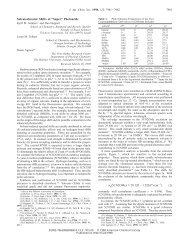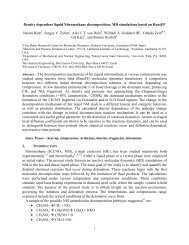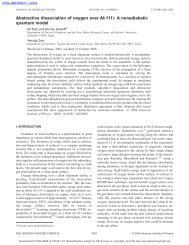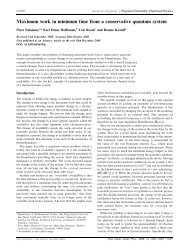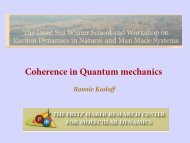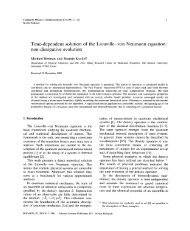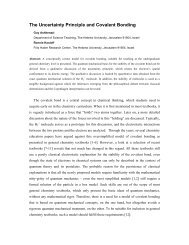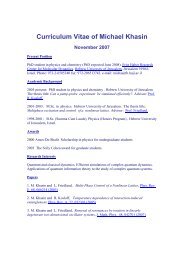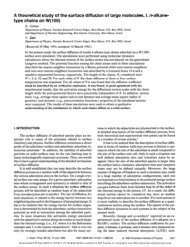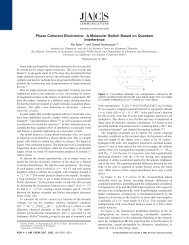Molecular Symmetry Properties of Conical Intersections and ...
Molecular Symmetry Properties of Conical Intersections and ...
Molecular Symmetry Properties of Conical Intersections and ...
You also want an ePaper? Increase the reach of your titles
YUMPU automatically turns print PDFs into web optimized ePapers that Google loves.
3006 J. Phys. Chem. A, Vol. 114, No. 9, 2010 Al-Jabour et al.<br />
(as explained above) is equal to π, allowing the assignment <strong>of</strong><br />
its charge e1 0,1 ) 1, within numerical accuracy; this is in accord<br />
with eq 22. Likewise, the value <strong>of</strong> the analogous contour integral<br />
for the loop with corresponding radial parameters r ) 1.0 <strong>and</strong><br />
0.8 Å, which does not include CI1 0,1 , is equal to zero, in accord<br />
with eq 23. These results confirm the self-consistency <strong>of</strong> the<br />
assignments <strong>of</strong> the same, positive signs <strong>of</strong> the values <strong>of</strong> the<br />
peaks <strong>of</strong> the τ 0,1 ({ ) π/2, r}) for the three cases, r ) 1.0, 0.8,<br />
<strong>and</strong> 1.2 Å, cf. Figure 6a-c.<br />
Second, theorem 15 relates the IREPs <strong>of</strong> the torsional NACTs<br />
τ i,j to the IREPs <strong>of</strong> all other τk i,j ; see also Table 1. Accordingly,<br />
the IREPs <strong>of</strong> the radial NACTs τr 0,1 , τr 0,2 , <strong>and</strong> τr 1,2 should be B2,<br />
B2, <strong>and</strong> A1, implying nodes for τr 0,1 ({r, }) <strong>and</strong> τr 0,2 ({r, }) at <br />
) π/2 but no node for τr 1,2 ({r, }). Quantum chemical<br />
calculations <strong>of</strong> the radial NACTs confirm this symmetry<br />
property <strong>of</strong> the radial NACTs, as demonstrated in<br />
Figure 7.<br />
The third test <strong>of</strong> the self-consistency <strong>of</strong> the IREPs <strong>of</strong> the<br />
torsional NACTs τ i,j is provided by the quantization rule for<br />
the so-called N × N topological matrix D(r) which depends on<br />
the NACTs. Specifically, D(r) is defined in terms <strong>of</strong> the N × N<br />
adiabatic-to-diabatic transformation (ADT) matrix, also called<br />
the A matrix (see ref 1, Chapter 4, <strong>and</strong> refs 37 <strong>and</strong> 38)<br />
A(r; ) ) P exp[- ∫ 0<br />
where τ is the antisymmetric N × N nonadiabatic coupling<br />
matrix with elements τ i,j , i, j ) 0, ... , N - 1, <strong>and</strong> P is the<br />
ordering operator. In the applications below, we consider the<br />
states S0, S1, <strong>and</strong> S2, thus, N ) 3; the starting point is 0 )-π,<br />
<strong>and</strong> the A matrix at the starting point is defined as the unity<br />
matrix, for convenience. Integration along a circular closed loop<br />
L(r) with radius r, i.e., from 0 to 0 + 2π, yields the topological<br />
matrix D(r) 13,28<br />
D(r) ) A(r,2π) ) P exp[- ∫ 0<br />
dτ (r; )]A(r; 0 ) (44)<br />
0+2π dτ (r; )]A(r; 0 )<br />
(45)<br />
It can be shown that D(r) is diagonal if the N states form a<br />
quasi-Hilbert subspace in the region surrounded by L(r).<br />
Furthermore, D is by construction an orthogonal matrix. Since<br />
it is diagonal <strong>and</strong> orthogonal, its diagonal elements are equal<br />
either to +1 orto-1. Moreover, it can be shown that the<br />
number <strong>of</strong> (-1)’s has to be even (ref 1, lemma 5.3 on p 119).<br />
We note in passing that the A matrix is called the ADT matrix<br />
because it may be used to transform the diagonal matrix<br />
V(r, ) for the adiabatic PES, V(r, )i,j ) Vj(r, )δi,j, into the<br />
diabatic potential matrix<br />
W(r, ) ) A(r, ) † V(r, )A(r, ) (46)<br />
Since A(r, ) is defined for torsional contours, W(r, ) is also<br />
defined for these contours. The quantization rule for the<br />
topological matrix guarantees that, in the limit <strong>of</strong> the closed<br />
circular contour, the diabatic matrix elements are single-valued,<br />
W(r, ) ) W(r, + 2π). Applications <strong>of</strong> the diabatic potentials<br />
based on the NACTs with proper IREPs for the MS C2V(v) to<br />
quantum dynamics simulations <strong>of</strong> photoexcited C5H4NH will<br />
be presented elsewhere.<br />
This quantization rule <strong>of</strong> the D matrix is a very sensitive test<br />
for the quantum chemical calculations <strong>of</strong> the NACTs in the<br />
Figure 7. Quantum chemistry results for the nodal properties <strong>of</strong><br />
the radial nonadiabatic coupling elements (NACTs) <strong>of</strong> C5H4NH, τr 0,1<br />
(a), τr 1,2 (b), <strong>and</strong> τr 0,2 (c), in a narrow domain close to π/2. Note the<br />
different scales. These results are consistent with their irreducible<br />
representations B2, A1, <strong>and</strong> B2, respectively, as deduced by the<br />
theorem 15 for the NACTs in the frame <strong>of</strong> the molecular symmetry<br />
group C2V(M), cf. Table 1.<br />
representative domain 0 e e π/2 (Figure 6a-c), as well as<br />
for the extensions to the global domain -π e e π based on<br />
their IREPs (Figure 6d-f): Any quantum chemical calculation<br />
<strong>of</strong> the NACTs <strong>and</strong> assignment <strong>of</strong> their IREPs that does not lead<br />
to a diagonal D matrix with an even number <strong>of</strong> (-1)’s can be<br />
ruled out.<br />
Applications <strong>of</strong> the third self-consistency test for the NACTs<br />
<strong>and</strong> their IREPs are demonstrated in Figure 8. Specifically,<br />
Figure 8a-c, d-f, <strong>and</strong> g-i show the elements <strong>of</strong> the A(r, )<br />
matrix for r ) 1.0, 0.8, <strong>and</strong> 1.2 Å, based on the NACTs τ i,j<br />
shown in Figure 6d, e, <strong>and</strong> f, respectively, in the domain -π e<br />
e +π. In the limit f π, the ADT matrix approaches the<br />
topological matrix D(r). It is gratifying that the numerical values<br />
<strong>of</strong> D(r) satisfy the quantization rule perfectly.



